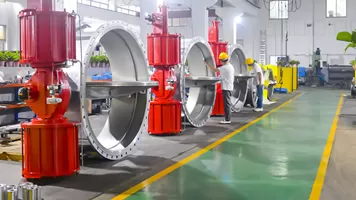In the vast arena of industrial applications, valves stand as the pivotal element in fluid control, their performance and efficiency directly influencing the smooth operation of production lines and the economic well-being of enterprises. This article delves into the unique characteristics of several mainstream valve types and focuses on the cutting-edge trends in valve optimization design, jointly envisioning the future of industrial valve technology.
Valve Performance Overview: Each With Its Own Merits
- Electric Ball Valves
Electric ball valves excel with their swift opening and closing speeds, precise flow control, and remarkable sealing capabilities. Design optimizations often emphasize enhancing motor responsiveness and accuracy, as well as employing more wear-resistant and corrosion-resistant materials to fortify the durability of the ball and seat. Furthermore, the integration of intelligent control systems enables remote monitoring and adjustment of electric ball valves, further enhancing operational convenience and system security.
- Gate Valves
Renowned for their high sealing performance and stability, gate valves are particularly suited for applications requiring prolonged closure. To optimize their performance, designers concentrate on minimizing friction between the stem and valve body, achieved through the adoption of novel lubricating materials or optimized stem structures. Additionally, reinforcing the hardness and wear resistance of the seat and disc is crucial to extending the service life of gate valves.
- Globe Valves
Globe valves are widely favored due to their simple structure and ease of operation. However, they have relatively limited flow regulation ranges and can impose significant fluid resistance. To address these drawbacks, modern globe valve designs emphasize flow path optimization, refining disc shapes and flow curves to minimize fluid resistance and enhance flow characteristics. Simultaneously, the adoption of novel sealing materials and structures ensures stable and reliable sealing performance.
- Electric Butterfly Valves
Electric butterfly valves, with their lightweight construction, swift opening and closing speeds, and excellent flow regulation capabilities, find widespread application across multiple industrial sectors. To further enhance their performance, designers continually refine disc shapes and sealing structures, reducing fluid resistance and improving sealing effectiveness. Furthermore, the integration of smart control technology allows electric butterfly valves to achieve precise flow control and remote monitoring, meeting the demands of increasingly complex industrial scenarios.
Optimization Design Frontier: Advancing Towards Excellence
- Material Innovation
Advancements in materials science have led to the widespread adoption of high-performance materials such as novel alloys, ceramics, and composites in valve manufacturing. These materials exhibit superior corrosion resistance, wear resistance, and stability under extreme conditions, thereby extending valve lifespans and reducing maintenance costs.
- Intelligent Control
Rapid advancements in intelligent control technology have opened new avenues for enhancing valve performance. By integrating sensors, actuators, and intelligent algorithms, valves can now perform self-diagnosis, fault prediction, and remote regulation. These capabilities not only improve valve operational efficiency and safety but also mitigate the risks and costs associated with manual operation.
- Eco-Friendly and Energy-Saving Design
Amidst global energy crises and environmental pressures, valve design has increasingly prioritized environmental protection and energy conservation. By optimizing flow path designs, minimizing fluid resistance, and enhancing sealing performance, valves can reduce energy losses and emissions. Additionally, the adoption of renewable materials and eco-friendly production processes represents a crucial direction for the future development of the valve industry.
In conclusion, the optimization design of valve performance serves as a vital driving force behind the advancement of industrial valve technology. Through continuous exploration and application of novel materials, technologies, and concepts, we can continually elevate valve performance levels, contributing to the efficient, safe, and sustainable development of industrial production.

